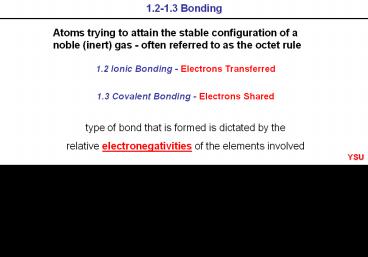Chemistry 3719 - Organic Chemistry I - PowerPoint PPT Presentation
Title:
Chemistry 3719 - Organic Chemistry I
Description:
Title: Chemistry 3719 - Organic Chemistry I Author: HP Authorized Customer Last modified by: Peter Norris Created Date: 8/26/2000 12:28:32 PM Document presentation format – PowerPoint PPT presentation
Number of Views:226
Avg rating:3.0/5.0
Title: Chemistry 3719 - Organic Chemistry I
1
1.2-1.3 Bonding
Atoms trying to attain the stable configuration
of a noble (inert) gas - often referred to as the
octet rule
1.2 Ionic Bonding - Electrons Transferred
1.3 Covalent Bonding - Electrons Shared
type of bond that is formed is dictated by the
relative electronegativities of the elements
involved
YSU
2
Electronegativity
YSU
the attraction of an atom for electrons
3
1.2 Ionic bonding
Electrons Transferred Big differences in E.N.
values Metals reacting with non-metals
YSU
4
Important Electronegativity Values
YSU
H 2.1 Li Be B C N O F 1.0 2.0 2.5 3.0 3.5 4.0
Cl 3.0 Br 2.8 I
2.5
5
1.3 Covalent Bonding - Similar electronegativities
H . H .
H H
Hydrogen atoms
Hydrogen molecule
B.D.E
104 kcal/mol
B.D.E
104 kcal/mol
B.D.E. bond dissociation energy
YSU
6
1.3 Lewis Dot Structures of Molecules
YSU
7
1.4 Double bonds and triple bonds
YSU
Double bonds - alkenes
Triple bonds - alkynes
8
1.5 Polar covalent bonds and electronegativity
H2 HF H2O CH4 CH3Cl
Based on electronegativity
YSU
9
1.6 Structural Formula - Shorthand in Organic
Chemistry
YSU
10
1.6 Constitutional Isomers
Same molecular formula, completely different
chemical and physical properties
YSU
11
1.7 Formal Charge
Formal charge group number - number
of bonds - number of unshared
electrons
YSU
12
1.8 Resonance Structures - Electron Delocalization
Table 1.6 formal rules for resonance
YSU
13
1.9 Shapes of Molecules
Shapes of molecules are predicted using VSEPR
theory
YSU
14
1.9 Shape of a molecule in terms of its
atoms Figure 1.9
Table 1.7 VSEPR and molecular geometry
YSU
15
YSU
16
Trigonal planar geometry of bonds to carbon in
H2CO
Linear geometry of carbon dioxide
YSU
17
1.10 Molecular dipole moments
Figure 1.7
YSU
18
1.11 Curved Arrows Extremely Important
- Curved arrows used to track flow of electrons in
chemical reactions. - Consider reaction shown below which shows the
dissociation of AB
YSU
19
Curved Arrows to Describe a Reaction
Many reactions involve both bond breaking and
bond formation. More than one arrow may be
required.
YSU
20
1.12 Acids and Bases - Definitions
Arrhenius An acid ionizes in water to give
protons. A base ionizes in water to give
hydroxide ions. Brønsted-Lowry An acid is a
proton donor. A base is a proton
acceptor. Lewis An acid is an electron pair
acceptor. A base is an electron pair donor.
YSU
21
1.13 A Brønsted-Lowry Acid-Base Reaction
A proton is transferred from the acid to the base.
H
A
B
B
A
H
Base acid
conjugate acid
conjugate base
YSU
22
Proton Transfer from HBr to Water
YSU
23
Equilibrium Constant for Proton Transfer
YSU
24
Acids and Bases Arrow Pushing
YSU
25
YSU
26
YSU
27
YSU
Need to know by next class pKa
-log10Ka STRONG ACID LOW pKa WEAK ACID
HIGH pKa HI, HCl, HNO3, H3PO4 pKa -10 to -5
Super strong acids H3O pKa
1.7 RCO2H pKa 5 acids PhOH pKa
10 get H2O, ROH pKa 16 weaker RCCH
(alkynes) pKa 26 RNH2 pKa 36 Extremely
weak acid RCH3 pKa 60 Not acidic at all
28
1.14 What happened to pKb?
- A separate basicity constant Kb is not
necessary. - Because of the conjugate relationships in the
Brønsted-Lowry approach, we can examine acid-base
reactions by relying exclusively on pKa values.
pKa 60 Essentially not acidic
Corresponding base Extremely strong
YSU
29
1.15 How Structure Affects Acid/Base Strength
YSU
- Bond Strength
- Acidity of HX increases (HIgtHBrgtHClgtHF) down the
periodic table as H-X bond strength decreases and
conjugate base (X- anion) size increases.
30
Electronegativity Acidity increases across
periodic table as the atom attached to H gets
more electronegative (HFgtH2OgtH2NgtCH4).
YSU
31
YSU
Inductive Effects Electronegative groups/atoms
remote from the acidic H can effect the pKa of
the acid.
pKa 16
pKa 11.3
- O H bond in CF3CH2OH is more polarized
- CF3CH2O- is stabilized by EW fluorine atoms
32
YSU
Resonance Stabilization in Anion Delocalization
of charge in anion (resonance) makes the anion
more stable and thus the conjugate acid more
acidic e.g. (CH3CO2H gt CH3CH2OH).
pKa 16
pKa 5
33
1.16 Acid-base reactions - equilibria
YSU
The equilibrium will lie to the side of the
weaker conjugate base
34
YSU
1.17 Lewis acids and Lewis bases
Product is a stable substance. It is a liquid
with a boiling point of 126C. Of the two
reactants, BF3 is a gas and CH3CH2OCH2CH3 has a
boiling point of 34C.































